Discover 35 hidden attractions, cool sights, and unusual things to do in Wiesbaden (Germany). Don't miss out on these must-see attractions: Biebrich Palace, Kurhaus, and Kirchgasse. Also, be sure to include St Elizabeth's Church in your itinerary.
Below, you can find the list of the most amazing places you should visit in Wiesbaden (Hesse).
Table of Contents
Biebrich Palace
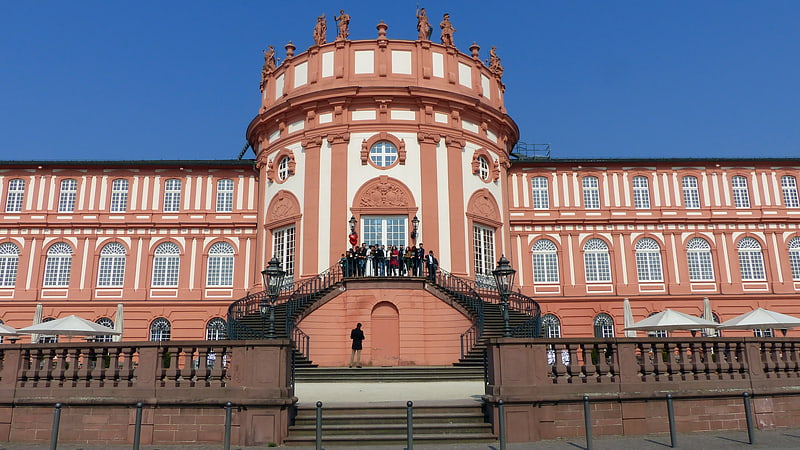
Also known as: Schloss Biebrich
Ornate baroque castle built in 1702. Biebrich Palace is a Baroque residence in the borough of Biebrich in the city of Wiesbaden, Hesse, Germany. Built in 1702 by Prince Georg August Samuel of Nassau-Idstein, it served as the ducal residence for the independent Duchy of Nassau from 1816 until 1866.[1]
Address: Rheingaustraße 140, 65203 Wiesbaden (Biebrich)
Kurhaus
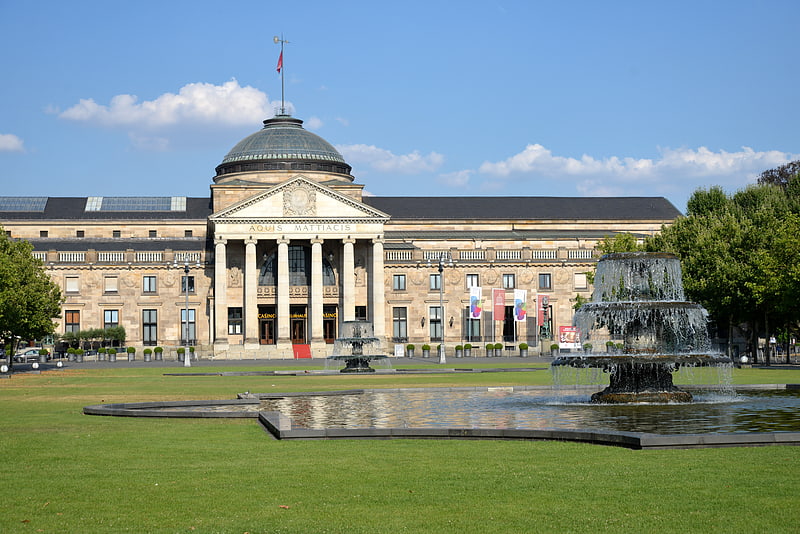
Function room facility in Wiesbaden, Germany. The Kurhaus is the spa house in Wiesbaden, the capital of Hesse, Germany. It serves as the city's convention centre, and the social center of the spa town. In addition to a large and a smaller hall, it houses a restaurant and the Wiesbaden Casino, or Spielbank, which is notable for allowing the "highest roulette stakes in Germany", and where Fyodor Dostoyevsky was said to have received the inspiration for his novel The Gambler.[2]
Kirchgasse
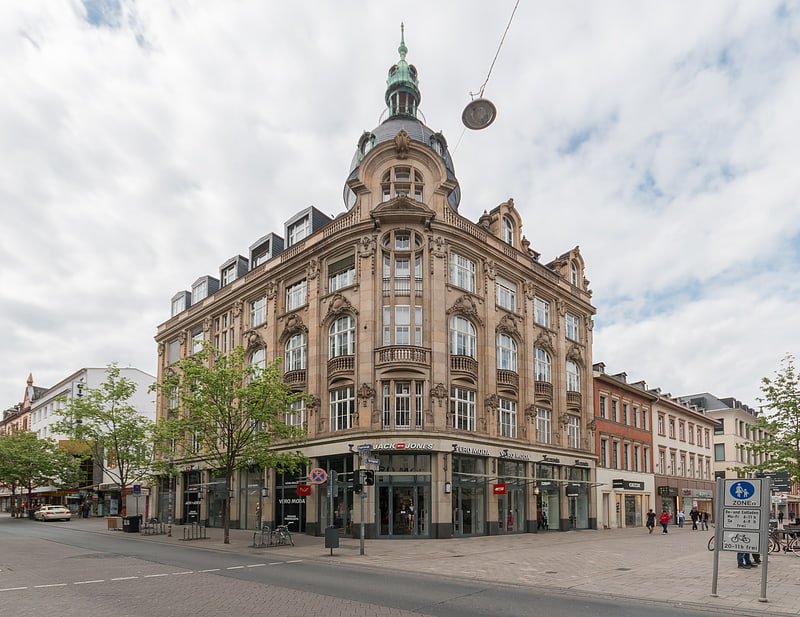
Street in Wiesbaden, Germany. The Kirchgasse is a shopping street in central Wiesbaden, Germany, and with roughly 11,000 people passing through every hour, it is one of the busiest shopping streets in Germany. The Kirchgasse is a designated pedestrian zone and spans about 500 meters from the Rheinstraße on the southern end to the Langgasse on the northern end. In 2007 a study has named the Kirchgasse the second most expensive street for retail property in Hesse, after the Zeil in Frankfurt am Main.[3]
St Elizabeth's Church
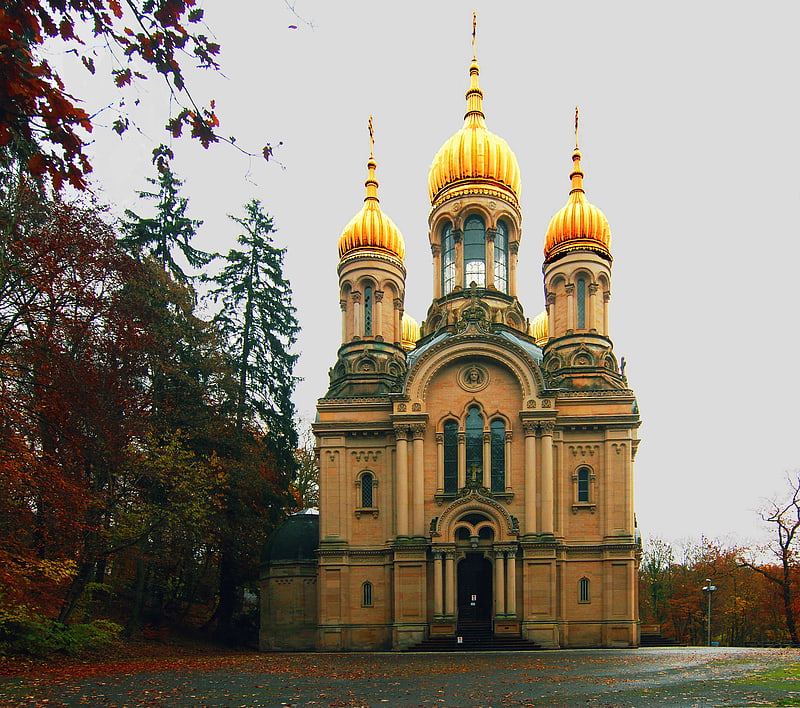
Also known as: Russisch-Orthodoxe Kirche
Iconic, 19th-century building with domes. The Russian Orthodox Church of Saint Elizabeth in Wiesbaden is the only Russian Orthodox church in Wiesbaden, Germany, and is located on Neroberg. Besides the Russian church there is a parsonage and a Russian cemetery, which is the largest in Europe. St. Elizabeth's Church and its parishioners belong to the Diocese of Germany in the Russian Orthodox Church Outside Russia.[4]
Address: Christian-Spielmann-Weg 1, 65193 Wiesbaden (Nordost)
Schloss Freudenberg
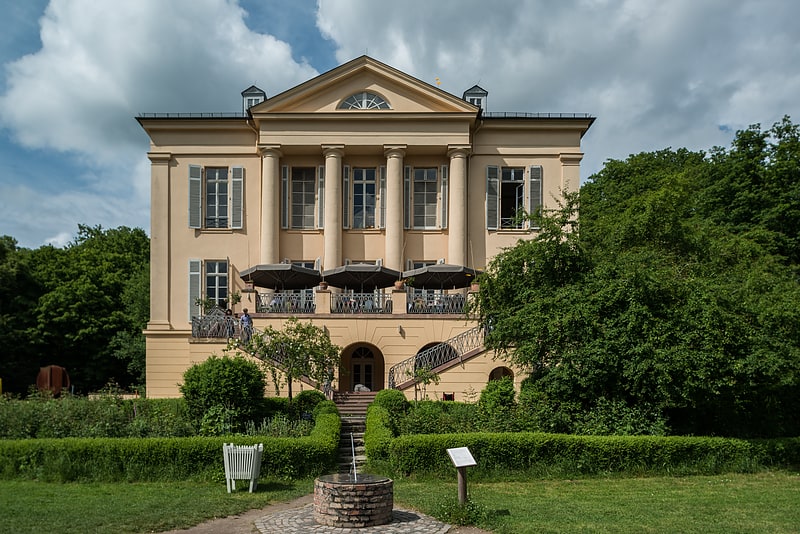
Museum in Wiesbaden, Germany. Schloss Freudenberg is a large villa in Wiesbaden, the capital of Hesse, Germany. It was built as a private residence in Dotzheim, and completed in 1904. The house and the large garden have been open to the public as an educational facility from 1993. Its exhibition in house and park is devoted to the experience of sensual perception.[5]
Address: Freudenbergstraße 224-226, 65201 Wiesbaden (Dotzheim)
Wiesbaden City Palace
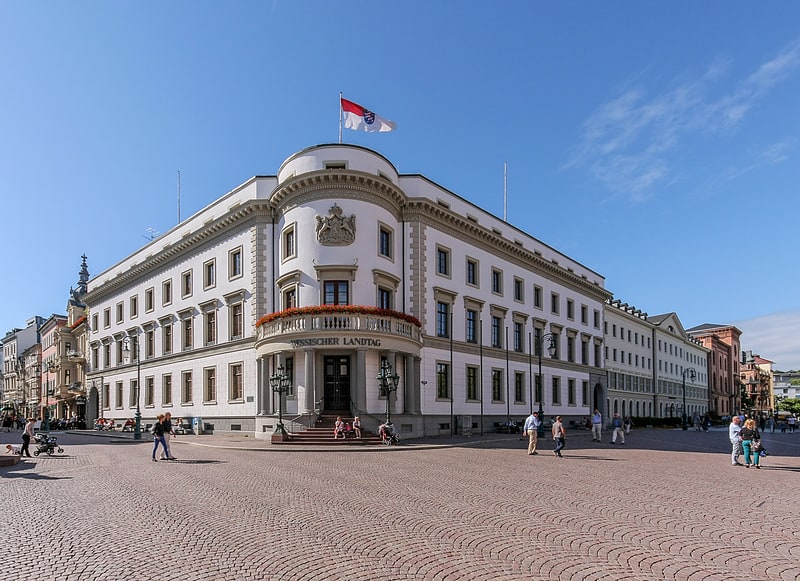
Also known as: Stadtschloss Wiesbaden
Neoclassical palace with guided tours. Wiesbaden City Palace is a neo-classical building in the center of Wiesbaden, Germany. It was completed in 1841 as the principal city residence of the Dukes of Nassau. The palace has several wings, 145 rooms, and is architecturally integrated with a group of ancillary buildings constructed both before and after it was built. With ornate towers, gables and a slate roof laid in herringbone patterns, the three-story complex lends charm and its name to the central square of Wiesbaden: Palace Square.
The Palace has had a turbulent history. After withstanding the Revolutions of 1848 and annexation by Prussia in 1866, it has served variously as a second home of the German Emperors, a gathering place for soldiers and workers during the German Revolution of 1918–1919, a museum, and a military headquarters for both the Wehrmacht and Allied occupation forces. Damaged during World War II, the Palace has since been restored and portions modernized. Since 1946 it has been the seat of the State Parliament of Hesse (German: Hessischer Landtag). A new Parliamentary Chamber was added to the complex in 2008.[6]
Address: Schlossplatz 1, 65183 Wiesbaden (Mitte)
Market Church
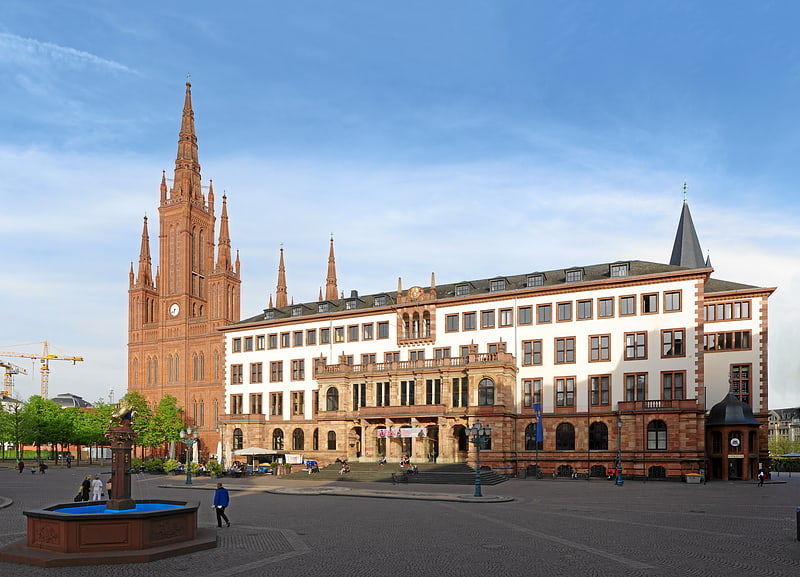
Also known as: Marktkirche
Monumental Gothic Revival church. Marktkirche is the main Protestant church in Wiesbaden, the state capital of Hesse, Germany. The neo-Gothic church on the central Schlossplatz was designed by Carl Boos and built between 1853 and 1862. At the time it was the largest brick building of the Duchy of Nassau. It is also called Nassauer Landesdom.[7]
Address: 5 Schloßplatz, Wiesbaden (Mitte)
Hessisches Staatstheater Wiesbaden

Theatre in Wiesbaden, Germany. The Hessisches Staatstheater Wiesbaden is a German theatre located in Wiesbaden, in the German state Hesse. The company produces operas, plays, ballets, musicals and concerts on four stages. Known also as the Staatstheater Wiesbaden or Theater Wiesbaden, its orchestra is the Hessisches Staatsorchester. The building was inaugurated in 1894.
The theatre is the host for the annual festival Internationale Maifestspiele Wiesbaden, established in 1896 after the Bayreuth Festival.[8]
Address: Christian-Zais-Str. 3, 65189 Wiesbaden (Nordost)
Museum Wiesbaden

Art, natural history and culture exhibits. The Museum Wiesbaden is a two-branch museum of art and natural history in the Hessian capital of Wiesbaden, Germany. It is one of the three Hessian State museums, in addition to the museums in Kassel and Darmstadt.[9]
Address: Friedrich-Ebert-Allee 2, 65185 Wiesbaden (Südost)
Ringkirche
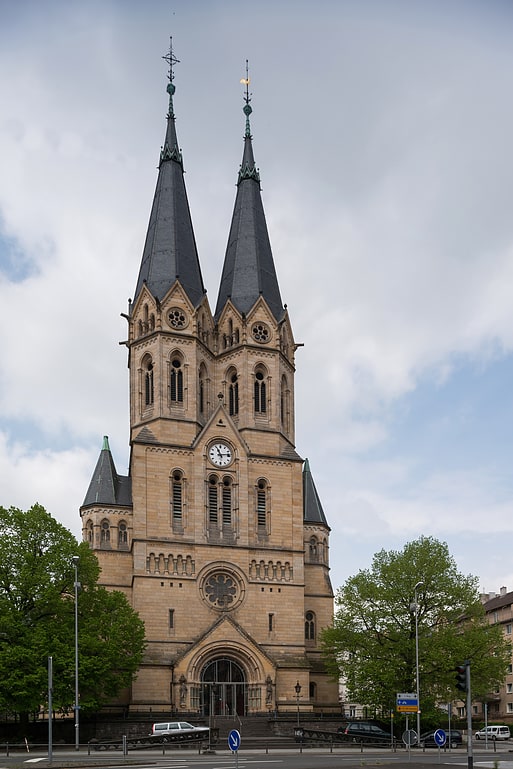
Church in Wiesbaden, Germany. The Ringkirche is a Protestant church in Wiesbaden, the state capital of Hesse, Germany. The Romanesque Revival church was built between 1892 and 1894 and designed by Johannes Otzen. The historic monument also serves as a concert venue.[10]
Address: Kaiser-Friedrich-Ring 7, 65185 Wiesbaden (Rheingauviertel - Hollerborn)
St. Bonifatius

Catholic church in Wiesbaden, Germany. St. Bonifatius in Wiesbaden, Germany, is the central Catholic parish and church in the capital of Hesse. The present building was designed by architect Philipp Hoffmann in Gothic Revival style and built from 1844 to 1849. Its twin steeples of 68 m dominate the Luisenplatz. The parish is part of the Diocese of Limburg.[11]
Address: Luisenstraße 27, 65185 Wiesbaden (Mitte)
Thermalbad Aukammtal
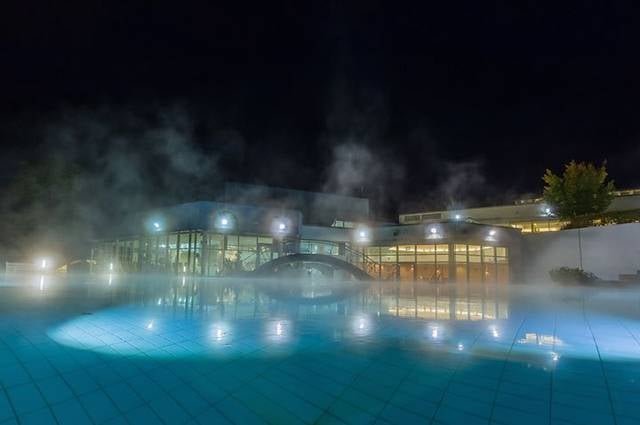
Amusement, Swimming, Water park, Amusement park, Spa, Hot springs
Address: Leibnizstr. 7, 65191 Wiesbaden (Bierstadt)
Warmer Damm
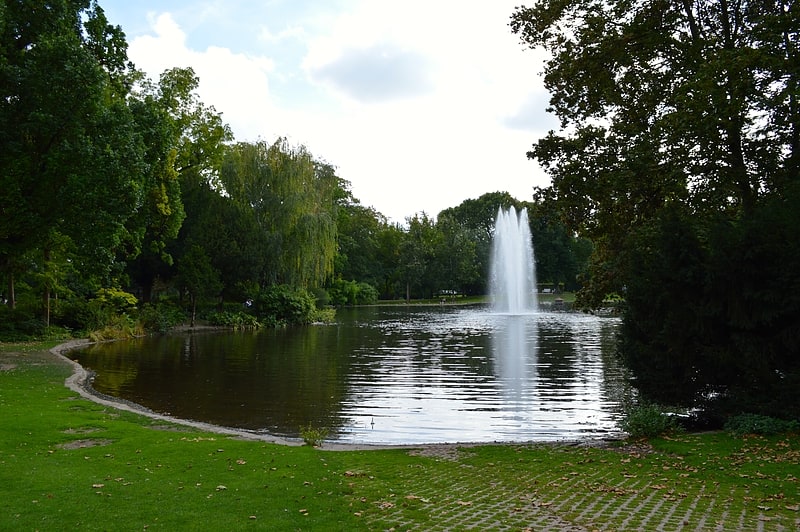
State park in Wiesbaden, Germany. The Warmer Damm is a public park in the centre of Wiesbaden, Germany, stretching from the Wilhelmstraße to the southern borders of the Kurpark and lying immediately in front of the Hessian State Theater. It was created between 1860 and 1861 as an English landscape park and includes a pond.[12]
Luther Church
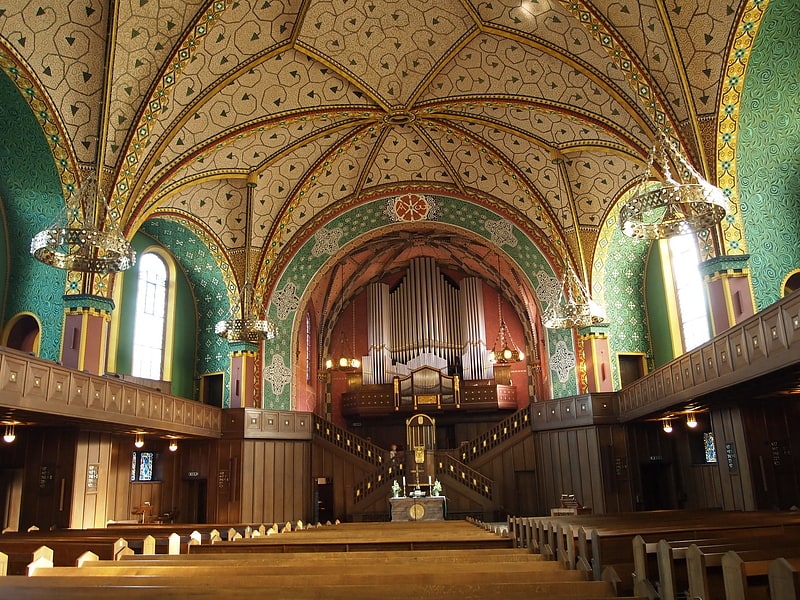
Also known as: Lutherkirche
Evangelical church in Wiesbaden, Germany. The Lutherkirche is one of four main Protestant churches in Wiesbaden, the capital of Hesse, Germany. It was built between 1908 and 1910 in Jugendstil and in accordance with the Wiesbadener Programm, to a design by Friedrich Pützer. With two organs and good acoustics, it is also a concert venue.[13]
Address: Sartoriusstraße 16, 65187 Wiesbaden (Südost)
New Town Hall
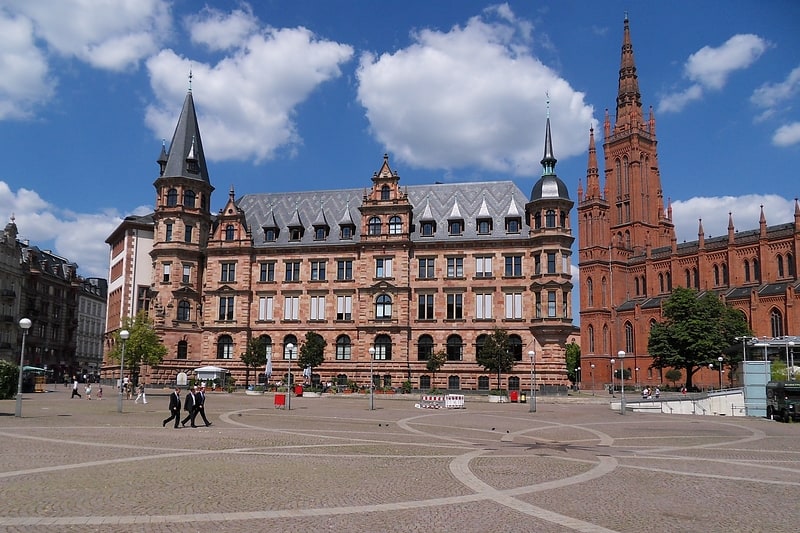
Also known as: Neues Rathaus
City or town hall in Wiesbaden, Germany. The New Town Hall is a town hall on the Schlossplatz in Wiesbaden, Hesse, Germany. It hosts the city government including the city council, offices of the mayors and part of the administration. It was built between 1884 and 1887 by Georg von Hauberrisser in a Renaissance Revival architecture style. The basement is almost completely occupied by a restaurant called Ratskeller.[14]
Address: Markt Platz, Wiesbaden (Mitte)
Bowling Green
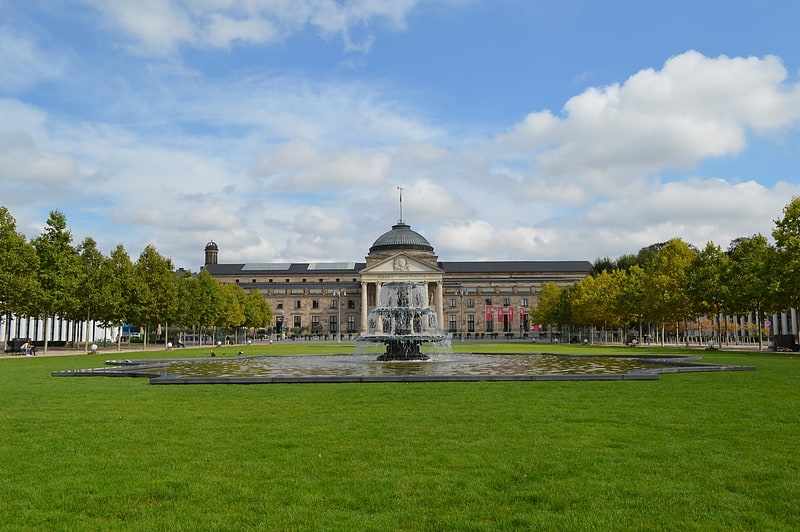
State park in Wiesbaden, Germany. The Bowling Green is a park in the Hessian state capital of Wiesbaden.
The Bowling Green is of an elongated rectangle with two pools, one of each in the middle of three shells cascading fountain stands. On the east side the park joins the Kurhausplatz in front of the Kurhaus, Wiesbaden. Close behind the Kurhaus with its famous casino, stretches the Kurpark. On the west side of Bowling Green runs the Wilhelmstrasse. Across the street lies the Kaiser-Friedrich-Platz with the statue of Emperor Frederick III. The place is flanked by the luxury Hotel Nassauer Hof.
The Bowling Green is often used for open-air events for example held concerts by David Gilmour, Leonard Cohen, R.E.M. Sting, Nelly Furtado, Bryan Adams, Plácido Domingo, Lionel Richie, Eric Clapton, Elton John and Herbert Grönemeyer.
In addition, the Bowling Green is a place for special events. Every year in June, occur the Wilhelmstrassen festival, one of the largest street parties in Germany - and every New Year's Eve the largest party in Wiesbaden take place here.[15]
Neroberg
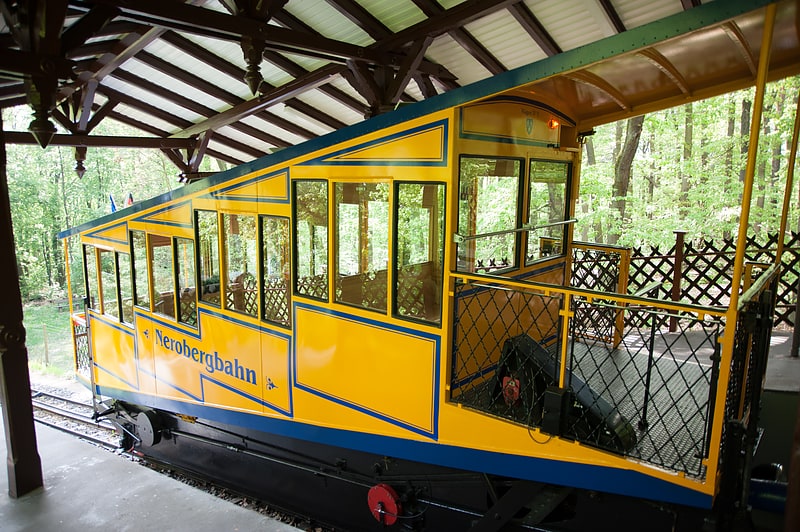
Historic hill with a funicular and trails. Neroberg is a hill in Wiesbaden in Hesse, Germany. It offers a panoramic view of the city and is therefore a tourist destination, reached by the historic Nerobergbahn, a funicular railway from the Nerotalanlagen.[16]
Christophoruskirche

Christian church in Wiesbaden, Germany. The Christophoruskirche is a Protestant church in the borough of Schierstein, Wiesbaden, Germany. It was built in 1752 to 1754 in the style of the late Baroque and Rococo.[17]
Address: Zehntenhofstraße 20, Wiesbaden (Schierstein)
Theodor Heuss Bridge
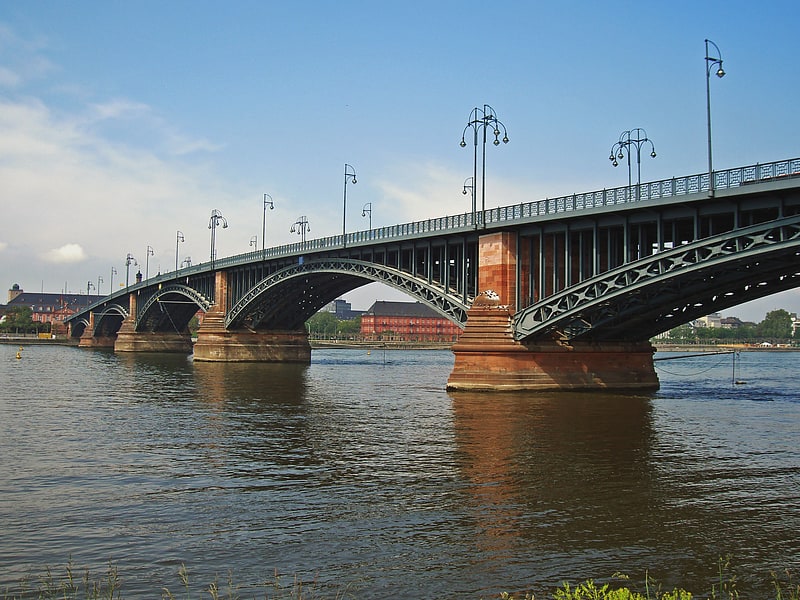
Also known as: Theodor-Heuss-Brücke
Arch bridge in Wiesbaden, Germany. The Theodor Heuss Bridge is an arch bridge over the Rhine River connecting the Mainz-Kastel district of Wiesbaden, capital of state Hesse and the Rhineland-Palatinate state capital Mainz. The main span of the bridge is 102.94 meters long. It connects the Bundesstraßes 40 and 455. Initially it was just called “Straßenbrücke”, later it was named after German statesman Theodor Heuss.
The Romans had built a bridge in this region in 27 AD, while the first arch bridge was inaugurated on 30 May 1885. Its construction costs of 3.6 million gold marks were recouped through tolls within three years although tolls continued to be levied until 1912. The bridge was widened from 1931 to 1934 but was destroyed on 17 March 1945 by German military engineers at the end of the second World War. To forestall a second Remagen, the Germans by 19 March had blown all Rhine bridges from Ludwigshafen northward.
It was rebuilt in the years 1948 to 1950 and partially reconstructed between 1992 and 1995 for a cost of 139.5 million marks.[18]
Frauenstein Castle
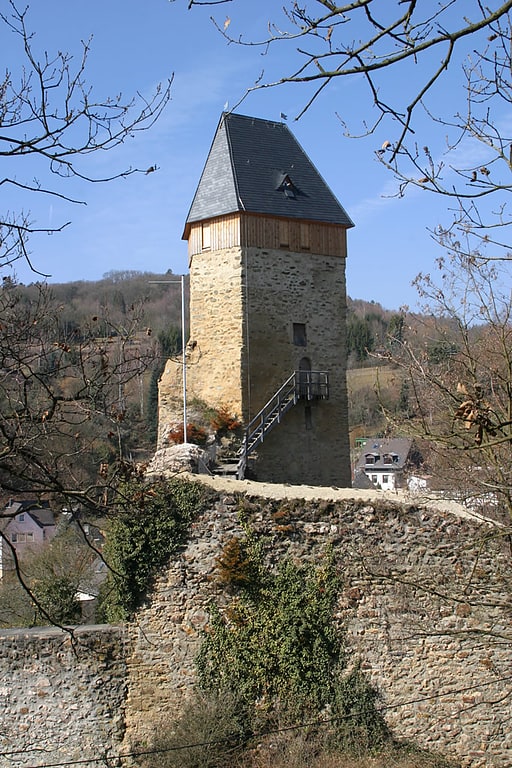
Also known as: Burg Frauenstein
Historical landmark in Wiesbaden, Germany. Frauenstein Castle is a ruined castle in the town of Wiesbaden-Frauenstein in Hesse, Germany.
It is not known who built Frauenstein Castle, but, based on dendrochronological evidence, its construction has been dated to around 1184. Built on a quartzite outcropping of the Spitzen Stein the castle was not intended as a defensive fortress, but rather as a watch-tower. It also served the tower guards as a dwelling. The construction of the castle with its high walls and battlements gave protection to farmers in the area and led to the emergence of the village of the same name. Later, the castle was extended by a fore-castle with pond, as could be confirmed by excavations in the year 1943.
While the German name Frauen-stein can be translated "women's stone", it actually derives from Vrowenstein, a name which first appears in the historical record in 1221. In that year, a deed names a Heinrich Bodo von Vrowenstein (in 1207/1209, he was mentioned as being from Idstein) as a lord of Frauenstein Castle. In the year 1231, a document of the Erbach monastery mentions a knight by the name of Siegfried von Frauenstein who was a marshal with the bishopric of Mainz. He was a descendant of an aristocratic Schierstein family (which would become extinct in 1380).
Around 1300, Siegfried IV von Frauenstein sold part of the castle, along with surrounding property and its serfs, to Gerhard, the Archbishop of Mainz. Gerhard wanted the castle in order to protect the eastern border of his possessions in the Rheingau against his rival, the Count of Nassau. In May 1301, forces of King Albert of Austria fought against Mainz. They captured all of the fortresses, including Frauenstein, and devastated the Rheingau. The castle was soon restored, however.
In 1310 Johann von Limburg also sold his shares of the castle to the Mainz bishopric so that it had gained full control over the castle by the year 1319. Mainz, however, once again sold parts of the castle so that, by 1390, it possessed only half of the castle. The noble co-owners often settled in Frauenstein and built beautiful half-timbered houses which still stand in the village to the present day.
Over the following centuries, the disputes between Mainz and Nassau continued. Nassau was able to prevent Mainz's possessions in the area from growing by encircling the castle with a chain of five fortified farms: Sommerberg, Rosenkoeppel, Nürnberg, Groroth, and Armada. All of these estates, with the exception of Rosenkoeppel, are still preserved today.
In the second half of the 18th century, the castle lost its significance as border security and was no longer maintained. In the Secularization of 1803, the town was brought under the control of the Count of Nassau and in 1808 the serfs were granted freedom of movement. In 1866, the town - like all of Nassau - came under the control of Prussia.[19]
Bergkirche

Evangelical church in Wiesbaden, Germany. The Bergkirche is one of four main Protestant churches in Wiesbaden, the capital of Hesse, Germany. It was completed in 1879 in Gothic Revival based on a design by Johannes Otzen. The church is focused on having the altar and pulpit close to the congregation, following Luther's concept of a universal priesthood. It also serves as a concert venue for church music.[20]
Address: Lehrstraße 6, 65183 Wiesbaden (Mitte)
Südfriedhof
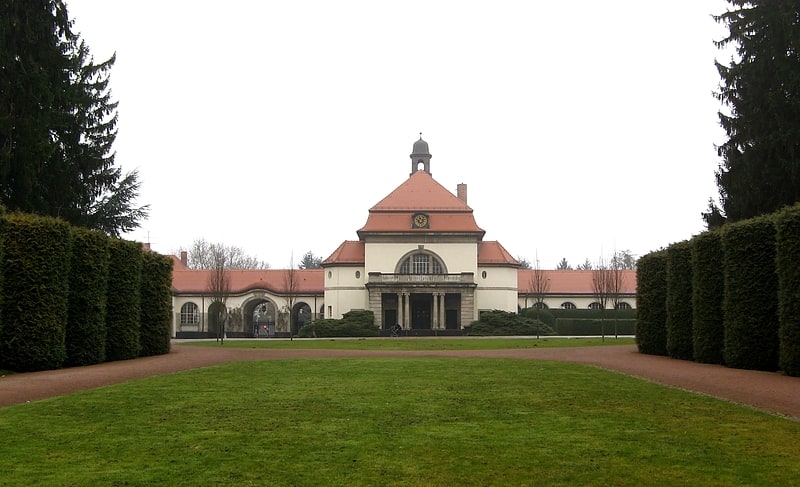
Cemetery in Wiesbaden, Germany. South Cemetery Wiesbaden is a cemetery in Wiesbaden, Germany. It was built according to the plans of Heinrich Zeininger.[21]
Address: 25 Siegfriedring, Wiesbaden (Südost)
Kaiserbrücke
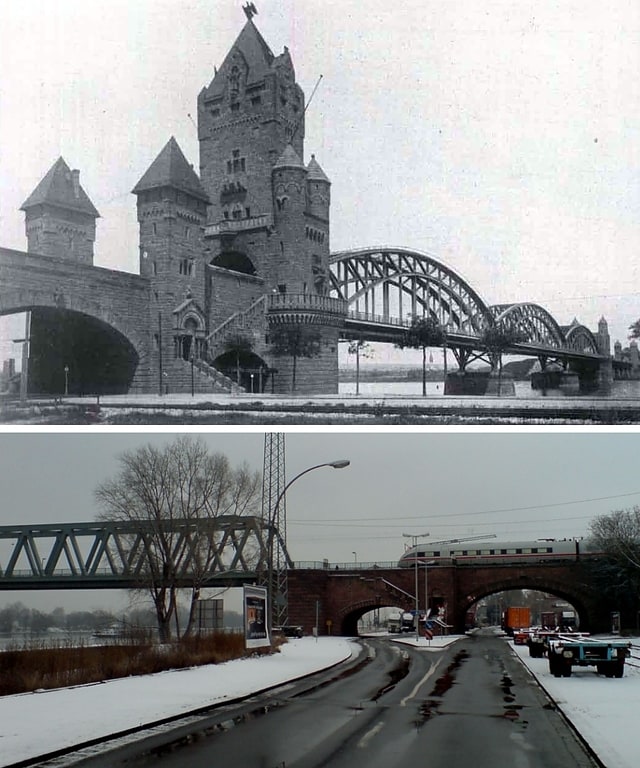
Truss bridge in Wiesbaden, Germany. The Kaiserbrücke, today officially the Nordbrücke, is a railway span on the Mainz rail bypass across the Rhine at the north end of Mainz in the state of Rhineland-Palatinate, Germany. Built between 1901 and 1904, it was named for the German Emperor Wilhelm II, who officially opened it on 1 May 1904. It formed an important part of the German railway system, as well as being an important logistical link for war transports.
The bridge was destroyed in 1945 by retreating German troops. To forestall a second Remagen, the Germans by 19 March had blown all Rhine bridges from Ludwigshafen northward.
It was later reopened in 1955 as the Nordbrücke (Northern Bridge), with parts of the surviving foundations and sculptures adorning it incorporated into the new much less grand structure. The neo-roman gate castles were not rebuilt. The former arched trusses were also replaced with box trusses.[22]
Spa Park
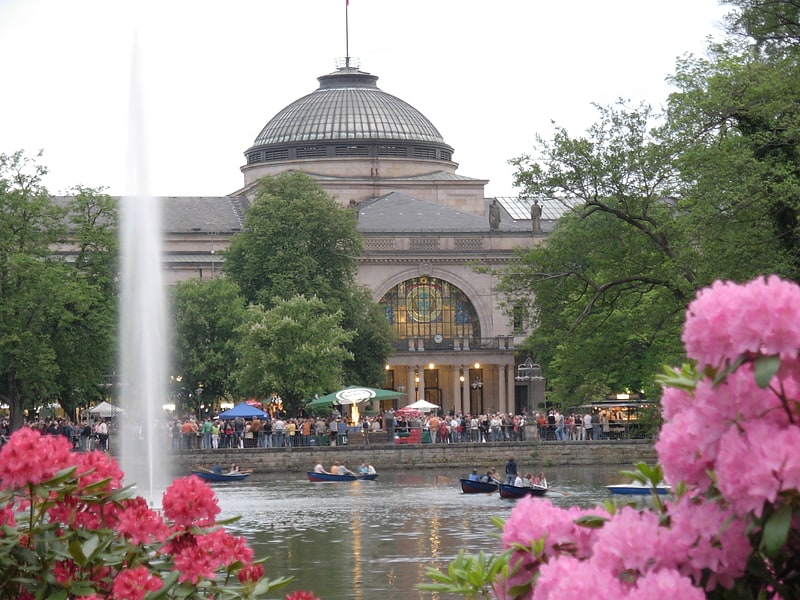
Also known as: Kurpark
Landscaped park with a lake and fountain. The Kurpark, German for "Spa Park", is a public park in the centre of Wiesbaden, Germany, stretching from the Wilhelmstraße to the southern borders of the district of Sonneberg and lying immediately behind the Kurhaus convention center. It was created in 1852 as an English landscape park and includes a lake where boats can be rented, and a 6 metres tall fountain. It has been described as the most beautiful park in Wiesbaden.[23]
Tier- und Pflanzenpark Fasanerie
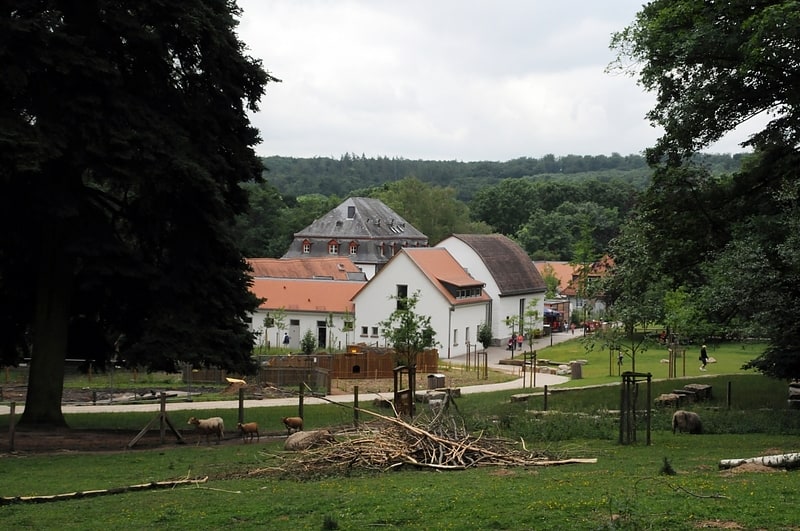
The Tier- & Pflanzenpark Fasanerie is operated by the state capital Wiesbaden and is located outside the city in the northwest in the Wiesbaden city forest on a spacious area of about 23 hectares.
The landscape is very diverse with hills, meadows, a high proportion of forest, streams and a lake. The buildings of a farm estate as well as the hunting lodge are under monument protection. In the surrounding area there is the former summer resort at the Chausseehaus, the Kaiser Wilhelm Tower on the Schläferskopf and the former Klarenthal Monastery.
Address: 22 Wilfried-Ries-Straße, Wiesbaden (Klarenthal)
Church of St Augustine of Canterbury
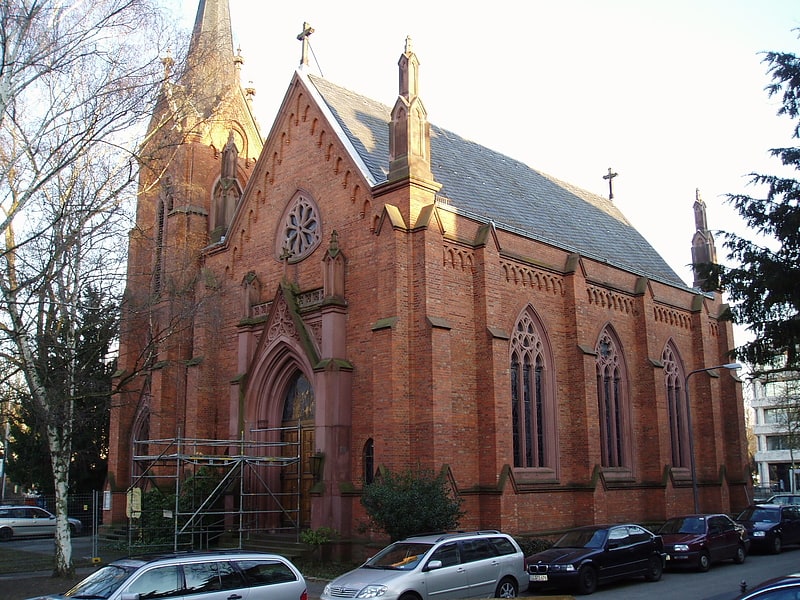
Also known as: St. Augustine’s of Canterbury
Parish church in Wiesbaden, Germany. The Church of St Augustine of Canterbury, commonly known as The English church at Wiesbaden, is a Hessian heritage-listed Anglican parish church located at Frankfurter Strasse 3 in Wiesbaden, Germany. Built in 1865 and named in honour of St Augustine of Canterbury, it was designed in the Gothic Revival style by city engineer Theodor Goetz. The church remains historically, socially, and architecturally significant.[24]
Address: Frankfurter Str. 3, 65189 Wiesbaden (Nordost)
Schläferskopf
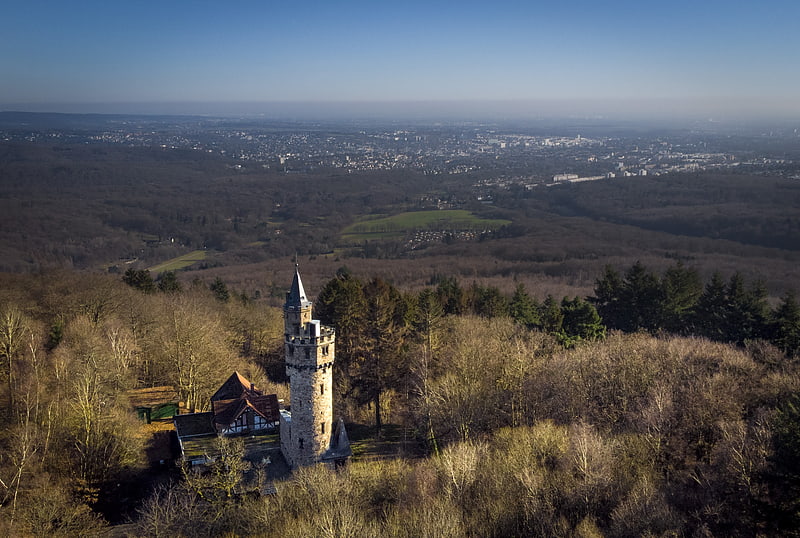
Hill in Germany. The Schläferskopf is a hill in Hesse, Germany, which is 454 metres high.[25]
Address: Schläferskopf 1, Wiesbaden (Dotzheim)
Kochbrunnen

Fountain in Wiesbaden, Germany. The Kochbrunnen in Wiesbaden is the most famous hot spring in city. It is a sodium chloride hot spring. Its name refers to the water temperature of about 66 °C.
The spring in the Kochbrunnenplatz was first mentioned in 1366 as Bryeborn (Brühborn) and 1536 as Syedenborn (Siedeborn). The productivity is about 360 litres every minute. The fountain has well water when exiting, at a temperature of 66.1 °C, smells faintly of hydrogen sulphide and has a strong salty taste. It is clear, but becomes turbid yellowish after 24 hours exposed to the air. The main flow is directed to the processing plant in the Kaiser-Friedrich-Bad. From there it passes into the extensive thermal water system of the city. It is used both for medicinal purposes (including in the hot springs in Aukammtal), as well as to heat the city hall.
Kochbrunnenplatz and neighbouring Kranzplatz host some of the Wiesbaden Grand Hotels: the oldest hotel in Germany, the "Schwarze Bock" founded in 1486; the former "Palace Hotel" – it was the first ever with room phones – and the "Hotel Rose", launched in September 2004 and which now hosts the Hessische Staatskanzlei.[26]
Address: Kochbrunnen platz, Wiesbaden (Mitte)
Hessian State Library

Also known as: Hochschul- und Landesbibliothek RheinMain
Library in Wiesbaden, Germany. The Wiesbaden State Library, formerly the Nassau State Library and Hessian State Library, is one of the state libraries of Germany. It is funded by the State of Hesse and located in Wiesbaden. With collections currently comprising over one million books, it is one of Germany's largest research libraries. The major special collection is on the historical state of Nassau, in which the library has its roots. As of 1 January 2011 it became part of the RheinMain University of Applied Sciences. The library building is situated in the Rheinstraße in central Wiesbaden.[27]
Address: Rheinstraße 55/57, Wiesbaden (Mitte)
Schloßplatz
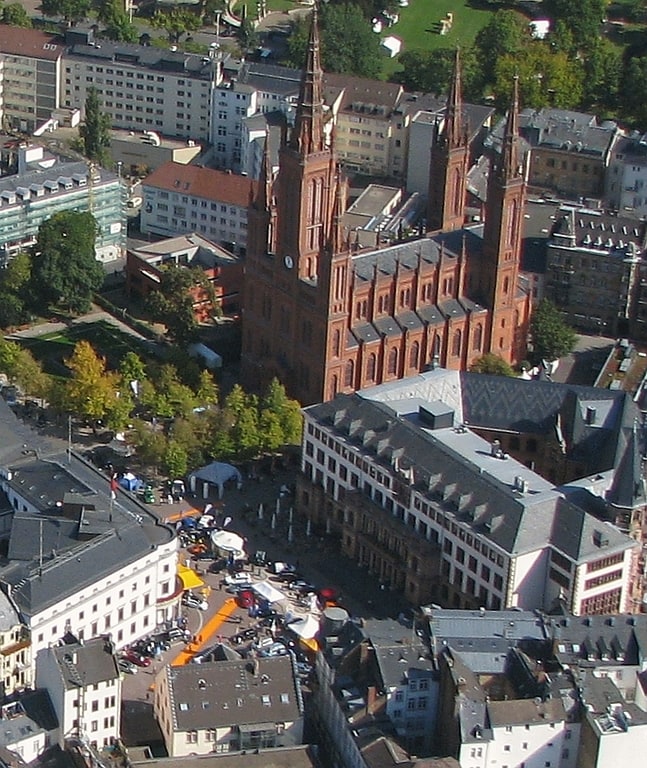
Also known as: Schlossplatz
The Schlossplatz forms the center of the historic Old Town of Wiesbaden, Hesse, Germany. It gets its name from the Stadtschloss, the royal residence of the Dukes of Nassau located on the north side of the square. Other buildings surrounding the Schlossplatz include the Old City Hall, the New Town Hall and the Marktkirche. In the middle of the square stands the Marktbrunnen of 1753. Due to this unique building ensemble, and the fact that at this point medieval Wiesbaden originated, it is historically the most important part of the city. Occasionally it is referred to as the "market square", its name before the palace was built.
The Schloßplatz was officially written as a proper noun using the letter 'ß' in the old German orthography. However, it was also correct to spell the word in new orthography as "Schlossplatz", which it often is.[28]
Biebrich
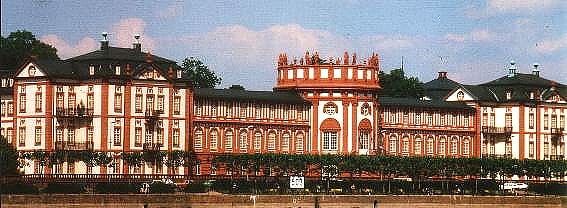
City in Germany. Biebrich is a borough of the city of Wiesbaden, Hesse, Germany. With over 38,000 inhabitants, it is the most-populated of Wiesbaden's boroughs. It is located south of the city center on the Rhine River, opposite the Mainz borough of Mombach. Biebrich was an independent city until it was incorporated into Wiesbaden in 1926.[29]
Rassel

Mountain in Germany. Rassel is a mountain of Hesse, Germany.[30]
Wiesbaden-Nordost
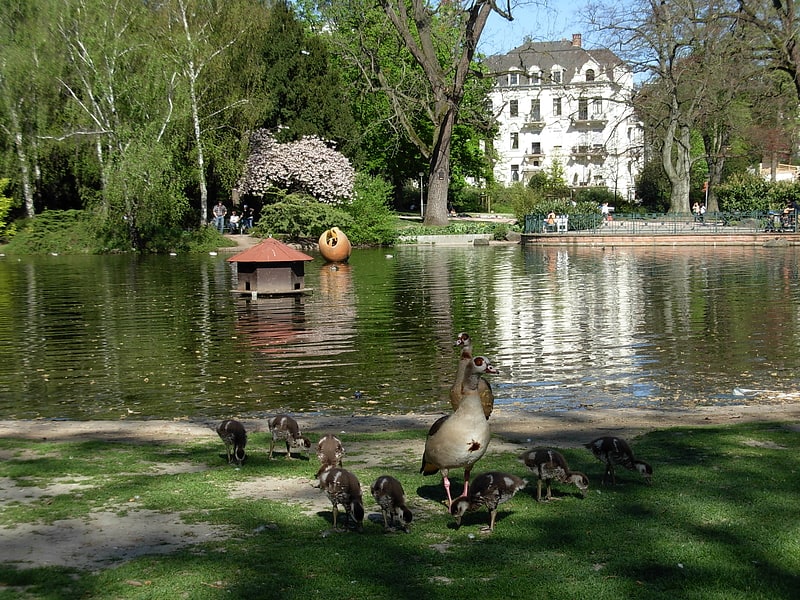
Nordost is a borough of the city of Wiesbaden, Hesse, Germany. With over 22,000 inhabitants, it is one of the most-populated of Wiesbaden's boroughs. It is located in the centre of the city. Nordost is known as the borough with the highest housing prices in Wiesbaden. Besides this Nordost has the highest purchasing power per inhabitant of all boroughs with about 29,000 Euro per inhabitant.[31]
Nassauischer Kunstverein Wiesbaden
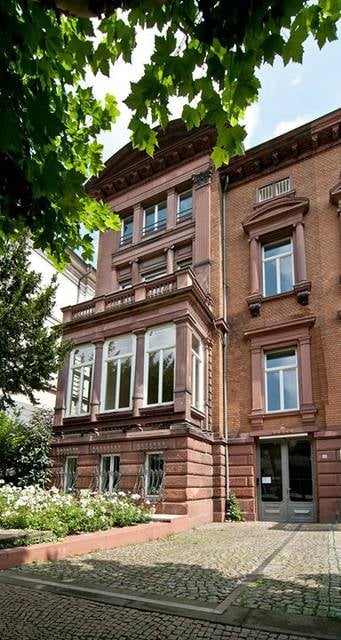
Museum, Art gallery
Address: Wilhelmstraße 15, Wiesbaden (Nordost)
Schierstein Bridge
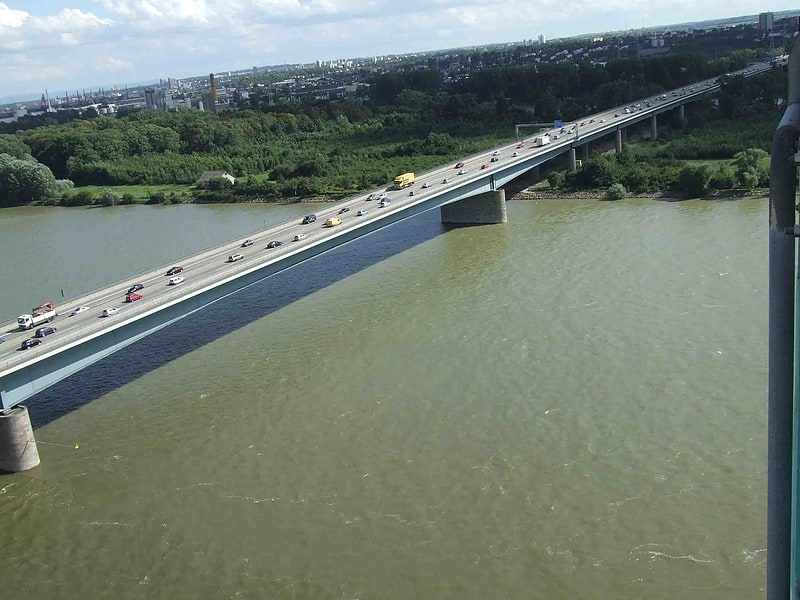
Also known as: Schiersteiner Brücke
Bridge in Wiesbaden, Germany. The Schierstein Bridge is 1,282-meter long, four-lane highway bridge in Germany. It carries Bundesautobahn 643 over the Rhine River between Mainz-Mombach, Rhineland-Palatinate and Wiesbaden-Schierstein, Hesse. Crossing two arms of the Rhine and the intervening island of Rettbergsaue, the bridge is made of six individual structures, including 100 m from prestressed concrete. It was built between 1959 and 1962.
The Schierstein Bridge is located about 5.8 km (3.6 mi) downstream of the Theodor Heuss Bridge. Together with the Theodor Heuss Bridge and the A 60 bridge, it is one of three road bridges across the Rhine at Mainz. It is the last bridge over the Middle Rhine for 80 kilometers (50 mi) downstream, before the Südbrücke in Koblenz.
From mid-February to mid-April 2015 the bridge was closed from all traffic due to extensive structural damage.[32]